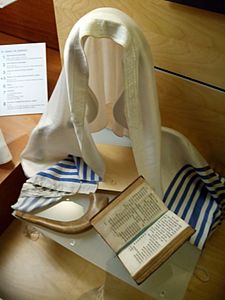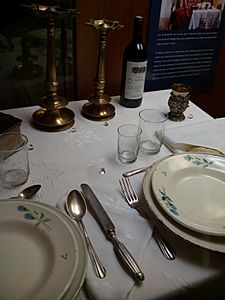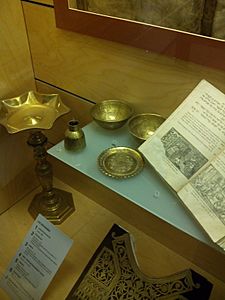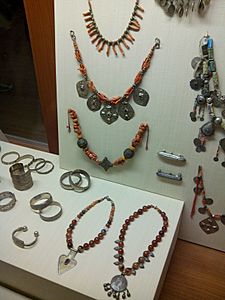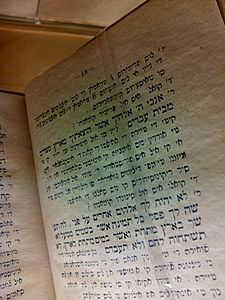Sephardic Museum (Toledo) facts for kids
| Museo Sefardí | |
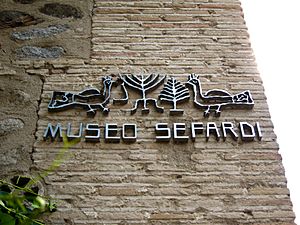 |
|
| Established | 13 June 1971 |
|---|---|
| Location | Calle Samuel Levi 2, Toledo, Spain |
| Owner | General State Administration |
The Sephardic Museum (which in Spanish is called Museo Sefardí) is a special museum in Toledo, Spain. It teaches visitors all about the Jewish culture and history in Spain. It also focuses on the Sephardim, who are the descendants of Jewish people who lived in Spain and Portugal until the year 1492.
The museum is located in an old building that used to be a convent for the Knights of Calatrava. It is right next to the famous El Tránsito Synagogue. This museum is one of Spain's National Museums and is part of the country's Ministry of Culture.
Contents
About the Museum's History
How the Museum Started
The idea for the Sephardic Museum began a long time ago, even before 1915. People wanted to gather all the important items of Jewish culture from different museums in Spain into one place. A special rule was made in 1964 to create the museum. Work to set it up started the very next year.
The museum officially opened its doors to visitors on June 13, 1971. At first, its collections were kept in rooms that used to hold old records of the Calatrava and Alcántara knight orders.
A National Treasure
Today, the Sephardic Museum is recognized as one of Spain's important National Museums. This means it is owned and managed by the Spanish government. It is connected to the Ministry of Culture, which helps make sure its valuable collections are cared for and shared with everyone.
The Story of the Jewish People
Ancient Roots in the Middle East
The first part of the museum takes you on a journey to the Middle East. This is where the Jewish people first lived and where many of their traditions began. You can see very old objects here, some from as far back as 2000 B.C. and up to the 1st century A.C.
These items help explain what Jewish life was like, including their beliefs and customs. A very important item on display is a Torah. This is a sacred book in Judaism, containing the first five books of the Hebrew Bible. You can also see other special objects used in Jewish religious practices.
Jewish Life in Spain
From Ancient Times to the Middle Ages
This part of the museum shows how Jewish people came to live in Spain. It covers their lives during the Roman and Visigoth times. You'll learn about their important contributions during the time of Al-Andalus (when parts of Spain were ruled by Muslims). It also shows their lives in the Christian kingdoms between the 13th and 15th centuries.
Challenges and Changes
The museum also explains some difficult times in Jewish history in Spain. This includes when some Jewish people were forced to change their religion. It also covers the Inquisition, which was a period when people were questioned about their beliefs. Finally, it tells about the expulsion of Jewish people from Spain in 1492.
Discoveries in the Courtyard
In the museum's north courtyard, you can see a special area called a necropolis. Here, some old gravestones of Jewish people from different parts of Spain are displayed. The courtyard also has archaeological remains. These are parts of what might have been public baths from Toledo's old Jewish quarter. You can also see the ground where the old Torah ark (a special cabinet for the Torah) of the synagogue once stood.
The Sephardim: Their Culture and Daily Life
Who are the Sephardim?
The word "Sepharad" comes from the Bible. For many centuries, Jewish people used "Sepharad" to mean Spain or the Iberian Peninsula. Later, the word "Sephardic" became a way to describe Jewish people who lived in medieval Spain.
A Glimpse into Daily Life
This section of the museum is located in the women's gallery. This was a special room in the synagogue where women could follow the religious services. In many Jewish traditions, women pray in a separate area from men.
The women's gallery still has some of its beautiful original decorations. Here, you can see displays about the daily life of the Sephardim. These displays cover important moments like birth, how children were educated, their main festivals, and traditions related to death.
Gallery
- Museum collection
See also
 In Spanish: Museo Sefardí para niños
In Spanish: Museo Sefardí para niños
- History of the Jews in Spain
- Sephardi Jewish culture in Spain


